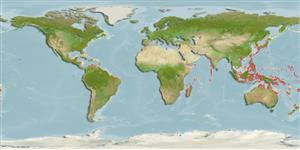Bivalvia |
Lucinida |
Lucinidae
Environment: milieu / climate zone / εύρος βάθους / distribution range
Οικολογία
; Υφάλμυρο; εύρος βάθους 0 - 4 m (Αναφ. 8252). Subtropical
Indo-West Pacific and Western Atlantic: from Red Sea and East Africa, through south east Asia and northern Australia to New Caledonia and Palau Islands. USA and Canada.
Length at first maturity / Μέγεθος / Weight / Age
Γεννητική Ωρίμανση: Lm ? range ? - ? cm Max length : 7.1 cm SHL αρσενικό/απροσδιόριστο; (Αναφ. 8252)
Associated with seaward fringe mangroves, where it deeply burrows up to 50 cm into intertidal and shallow subtidal muds and sands (Ref. 77670).
Life cycle and mating behavior
Γεννητική Ωρίμανση | Αναπαραγωγή | Γεννοβολία | Eggs | Γονιμότητα | Larvae
Members of the class Bivalvia are mostly gonochoric, some are protandric hermaphrodites. Life cycle: Embryos develop into free-swimming trocophore larvae, succeeded by the bivalve veliger, resembling a miniature clam.
Glover, E.A. and J.D. Taylor 2007 Diversity of chemosymbiotic bivalves on coral reefs: Lucinidae (Mollusca, Bivalvia) of New Caledonia and Lifou. Zoosystema 29(1):109-181. (Αναφ. 8252)
IUCN Red List Status
(Αναφ. 130435: Version 2025-1)
CITES status (Αναφ. 108899)
Not Evaluated
Not Evaluated
Threat to humans
Human uses
| FishSource |
Εργαλεία
Περισσότερες πληροφορίες
Τροφική ΟικολογίαFood items (preys)
Σύσταση δίαιτας
Κατανάλωση τροφής
Θηρευτές
Population dynamicsΑύξηση
Max. ages / sizes
Length-weight rel.
Length-length rel.
Length-frequencies
Mass conversion
Αφθονία
Life cycleΑναπαραγωγήΓεννητική ΩρίμανσηΓονιμότηταΓεννοβολίαEggsEgg developmentLarvae PhysiologyΚατανάλωση οξυγόνου
Human RelatedStamps, coins, misc.
Διαδικτυακές πηγές
Estimates based on models
Preferred temperature
(Ref.
115969): 6.4 - 28.9, mean 27.1 (based on 3438 cells).
Fishing Vulnerability
Low vulnerability (10 of 100).
Price category
Unknown.
